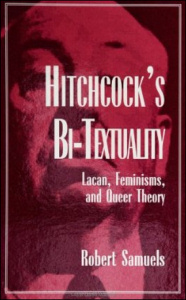Hitchcock's Bi-Textuality: Lacan, Feminisms, and Queer Theory (1997) by Robert Samuels
 | |
| Robert Samuels | |
| Suny Series in Psychoanalysis and Culture | |
| State University of New York Press (1997) | |
| ISBN 0791436101 | |
| LibraryThing | |
Product Links
Synopsis
This book combines three elements: an articulation of Lacan's theory of ethics; a discussion of recent theories of feminine subjectivity and queer textuality; and close readings of Hitchcock's films. Hitchcock's Bi-Textuality argues that just as Freud posited a fundamental ground of bisexuality for every subject, we can affirm a form of universal "bi-textuality" that is repressed through different modes of representation, yet returns in unconscious aspects of textuality (dreams, word play, jokes, and symbolism). In order to illustrate this notion of bi-textuality, this work discusses how Hitchcock's films are extremely heterogeneous and present multiple forms of sexual identification and desire, although they have most often been read through the reductive lens of male heterosexuality. Throughout this book, the work of Julia Kristeva, Kaja Silverman, Judith Butler, Luce Irigaray, and Slavoj Žižek is examined. One of the central concerns is the way that different psychoanalytic and feminist theories tend to equate the Real and the unconscious with the feminine. This feminization of the Real tends to block the awareness of the bisexual nature of the unconscious. In order to return to Freud's fundamental theory of polyvalent sexuality, recent notions of queer sexuality and textuality are explored. This book extends psychoanalytic theory by incorporating new feminist and queer conceptions of sexuality and representation.
Reviews
- Choice (1998) - Hitchcock's bi-textuality: Lacan, feminisms, and queer theory
- Hitchcock Annual (1998) - "Hitchcock's Bi-Textuality: Lacan, Feminisms, and Queer Theory" by Robert Samuels
- Hitchcock Annual (1999) - Hitchcock's Bi-Textuality: Lacan, Feminisms, and Queer Theory
